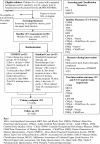COMBIT: protocol of a randomised comparison trial of COMbined modified constraint induced movement therapy and bimanual intensive training with distributed model of standard upper limb rehabilitation in children with congenital hemiplegia
- PMID: 23809257
- PMCID: PMC3750247
- DOI: 10.1186/1471-2377-13-68
COMBIT: protocol of a randomised comparison trial of COMbined modified constraint induced movement therapy and bimanual intensive training with distributed model of standard upper limb rehabilitation in children with congenital hemiplegia
Abstract
Introduction: Children with congenital hemiplegia often present with limitations in using their impaired upper limb which impacts on independence in activities of daily living, societal participation and quality of life. Traditional therapy has adopted a bimanual training approach (BIM) and more recently, modified constraint induced movement therapy (mCIMT) has emerged as a promising unimanual approach. Evidence of enhanced neuroplasticity following mCIMT suggests that the sequential application of mCIMT followed by bimanual training may optimise outcomes (Hybrid CIMT). It remains unclear whether more intensely delivered group based interventions (hCIMT) are superior to distributed models of individualised therapy. This study aims to determine the optimal density of upper limb training for children with congenital hemiplegia.
Methods and analyses: A total of 50 children (25 in each group) with congenital hemiplegia will be recruited to participate in this randomized comparison trial. Children will be matched in pairs at baseline and randomly allocated to receive an intensive block group hybrid model of combined mCIMT followed by intensive bimanual training delivered in a day camp model (COMBiT; total dose 45 hours direct, 10 hours of indirect therapy), or a distributed model of standard occupational therapy and physiotherapy care (SC) over 12 weeks (total 45 hours direct and indirect therapy). Outcomes will be assessed at 13 weeks after commencement, and retention of effects tested at 26 weeks. The primary outcomes will be bimanual coordination and unimanual upper-limb capacity. Secondary outcomes will be participation and quality of life. Advanced brain imaging will assess neurovascular changes in response to treatment. Analysis will follow standard principles for RCTs, using two-group comparisons on all participants on an intention-to-treat basis. Comparisons will be between treatment groups using generalized linear models.
Trial registration: ACTRN12613000181707.
Figures
Similar articles
-
INCITE: A randomised trial comparing constraint induced movement therapy and bimanual training in children with congenital hemiplegia.BMC Neurol. 2010 Jan 12;10:4. doi: 10.1186/1471-2377-10-4. BMC Neurol. 2010. PMID: 20064275 Free PMC article. Clinical Trial.
-
Randomized trial of constraint-induced movement therapy and bimanual training on activity outcomes for children with congenital hemiplegia.Dev Med Child Neurol. 2011 Apr;53(4):313-20. doi: 10.1111/j.1469-8749.2010.03859.x. Dev Med Child Neurol. 2011. PMID: 21401585 Clinical Trial.
-
Constraint-induced movement therapy in children with unilateral cerebral palsy.Cochrane Database Syst Rev. 2019 Apr 1;4(4):CD004149. doi: 10.1002/14651858.CD004149.pub3. Cochrane Database Syst Rev. 2019. PMID: 30932166 Free PMC article.
-
REACH: study protocol of a randomised trial of rehabilitation very early in congenital hemiplegia.BMJ Open. 2017 Sep 18;7(9):e017204. doi: 10.1136/bmjopen-2017-017204. BMJ Open. 2017. PMID: 28928195 Free PMC article. Clinical Trial.
-
Intensive upper extremity training for children with hemiplegia: from science to practice.Semin Pediatr Neurol. 2013 Jun;20(2):100-5. doi: 10.1016/j.spen.2013.06.001. Semin Pediatr Neurol. 2013. PMID: 23948684 Review.
Cited by
-
Characterization and intervention for upper extremity exploration & reaching behaviors in infancy.J Hand Ther. 2015 Apr-Jun;28(2):114-24; quiz 125. doi: 10.1016/j.jht.2014.12.003. Epub 2014 Dec 13. J Hand Ther. 2015. PMID: 25835251 Free PMC article.
-
Circus Activities as a Health Intervention for Children, Youth, and Adolescents: A Scoping Review.J Clin Med. 2023 Mar 4;12(5):2046. doi: 10.3390/jcm12052046. J Clin Med. 2023. PMID: 36902836 Free PMC article.
-
A Pilot Feasibility Study on the Use of Dual-Joystick-Operated Ride-on Toys in Upper Extremity Rehabilitation for Children with Unilateral Cerebral Palsy.Children (Basel). 2024 Mar 29;11(4):408. doi: 10.3390/children11040408. Children (Basel). 2024. PMID: 38671624 Free PMC article.
-
Alterations in regional shape on ipsilateral and contralateral cortex contrast in children with unilateral cerebral palsy and are predictive of multiple outcomes.Hum Brain Mapp. 2016 Oct;37(10):3588-603. doi: 10.1002/hbm.23262. Epub 2016 Jun 3. Hum Brain Mapp. 2016. PMID: 27259165 Free PMC article.
-
Mitii™ ABI: study protocol of a randomised controlled trial of a web-based multi-modal training program for children and adolescents with an Acquired Brain Injury (ABI).BMC Neurol. 2015 Aug 19;15:140. doi: 10.1186/s12883-015-0381-6. BMC Neurol. 2015. PMID: 26286324 Free PMC article. Clinical Trial.
References
-
- Stanley F, Blair E, Alberman E. Cerebral palsies: Epidemiology and causal pathways. London: Mac Keith; 2000.
-
- Wiklund LM, Uvebrant P. Hemiplegic cerebral palsy. Correlation between CT morphology and clinical findings. Dev. Med & Child Neurology. 1991;33:512–523. - PubMed
-
- Sakzewski L, Boyd R, Ziviani J. Clinimetric properties of participation measures for 5- to 13-year-old children with cerebral palsy: a systematic review. Dev. Med. & Child Neurology. 2007;49:232–240. - PubMed
-
- Sakzewski L, Ziviani J, Boyd R. Systematic review and meta-analysis of therapeutic management of upper limb dysfunction in children with congenital hemiplegia. Pediatrics. 2009;123:E1111–E1122. - PubMed
-
- Taub E, Ramey SL, DeLuca S, Echols K. Efficacy of constraint-induced movement therapy for children with cerebral palsy with asymmetric motor impairment. Pediatrics. 2004;113:305–312. - PubMed
Publication types
MeSH terms
Substances
LinkOut - more resources
Full Text Sources
Other Literature Sources


